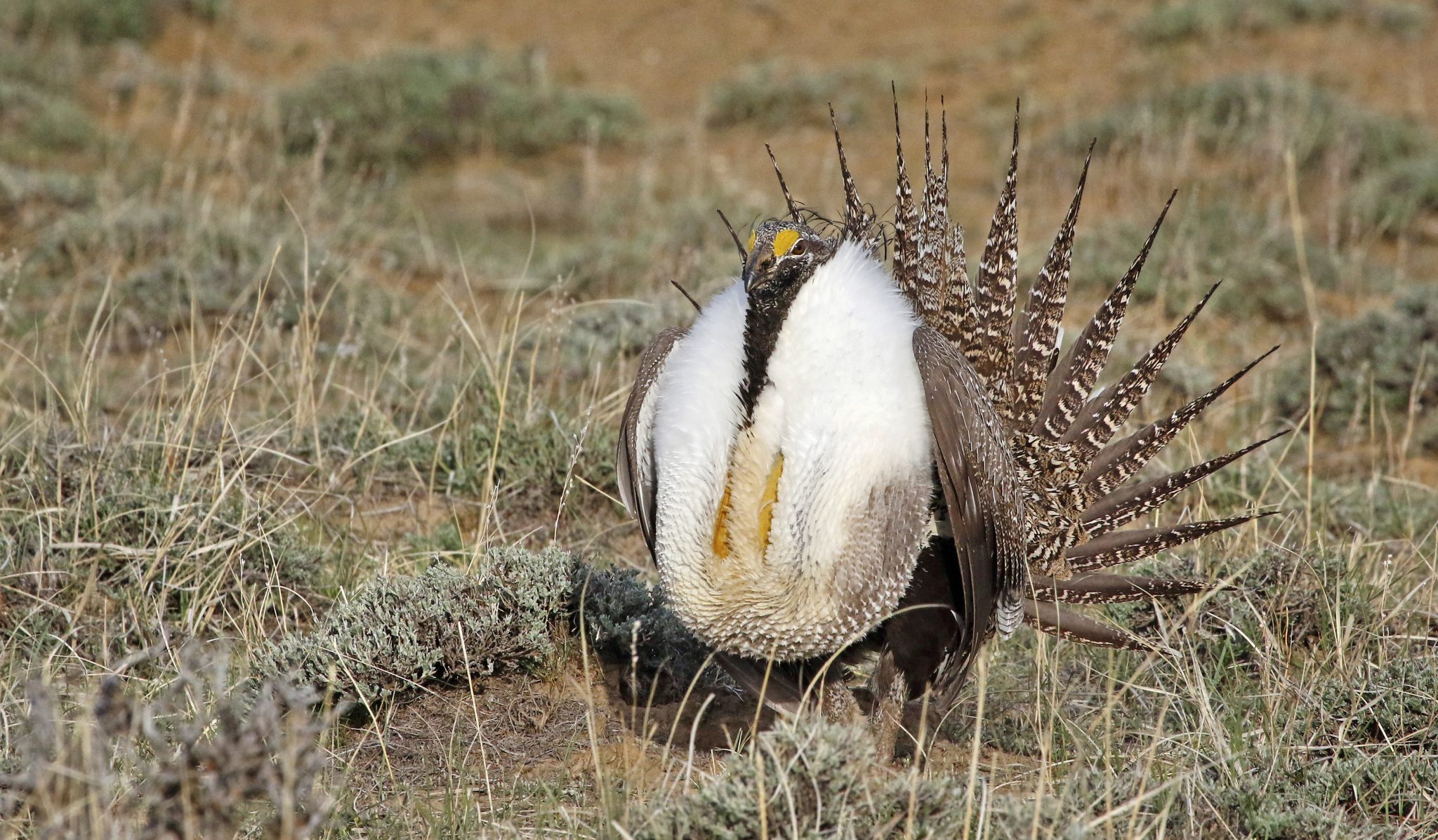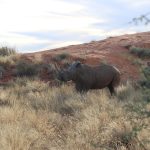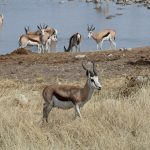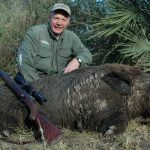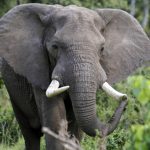Photo by Vic Schendel
Many think species protection requires the ending of hunting and protection by the government. Neither are true.
It was the last clear, bright day of September, and I went out onto the plains to hunt sage grouse. A brace of the oversized birds makes a limit, but there’s still the kicking up of them among the brush and cactus, and seeing the English cocker run, overjoyed. These are birds to pluck, much too special to skin before eating.
It occurred to me as I hunted that the sage grouse had gone from straightforward upland game to a genuine trophy bird–like the wild turkey or the Eurasian capercaille. A cockbird mounted with its spiky pinnated tail feathers fanned, wings down, white breast feathers fluffed, and gular sacs expanded (curiously reminiscent of Mae West bundled in white furs at a Hollywood premiere), is a striking, unique addition to a hunter’s home.
With that in mind, I e-mailed an old friend who is a guide and outfitter in the grouse’s home range, asking if he could recommend anyone I might recommend to readers to take them hunting. I thought more hunters should get to know the bird, gain an appreciation of it, and take an interest in its well-being as a species.
My friend’s somewhat gratuitous reply: “Sorry Tom, but sage grouse have become as rare as hen’s teeth, so we don’t hunt them anymore. They used to be common, now we’re just trying to protect the vestiges of that population.” This is from a professional hunting guide, someone who should know that no game species is more orphaned than one nobody hunts anymore.
I realize many sincerely believe the sage grouse to be standing on a precipice, and certainly conscientious efforts at conservation must be, and are being, made. Yet probably much of the energy expended in attempting to get the bird placed among the animals covered by the Endangered Species Act of 1973 is motivated by the desire to give the federal government increased power over the management of millions of acres, both public and private, that the grouse inhabits in almost a dozen Western states, and to take away power from the “yokels” who already live there. And one of the tactics of those wishing to see the bird listed is the claim that this will protect it from hunters, as always the “usual suspects” in the decline of any species.
The grouse’s situation is complex, but the implications of those advocating for ESA status are clear: not hunting an animal is how you save it–and even hunting guides, it seems, can be made to believe this simplistic notion. Add to that the other suggestion, that it takes the central government to preserve it. But how true is that?
Central governments have for years encouraged and/or orchestrated the killing of wildlife on a grand scale, especially predators. Take the British as an example. The cause of the tiger’s waning on the subcontinent is most often placed in the hands of pith-helmeted “Bungalow Bills” seated in howdahs on the backs of elephants. Mark Twain, though, writing about his travels in British India in the mid-1890s, noted that “the government’s work is quite uniform. . . it about doubles the tiger’s average” of killing, each individual instance of man–eating by the species met by the officially sanctioned culling of twice as many tigers—80,000 big cats were destroyed in this fashion from 1875 to 1925 (after ending sport hunting in 1971, India turned some 1,800 remaining tigers into 1,411 after 34 years of “protection” and the expenditure of $400 million in “conservation” funds).
Touring Britain’s East African territories in 1907 as Under Secretary of State for the Colonies, Winston Churchill promised, “Zebra, rhinoceros, buffalo, and other picturesque and fascinating nuisances will be driven from or exterminated within the settled areas, and confined to the ample reserves of uninhabited land.” True to Churchill’s words, and as just one instance, famed professional hunter, J. A. Hunter, was tasked by the Kenya-colony government with killing 1,000 rhinos to sweep a region clean for a hopeless agricultural scheme.
As President in 1906, the hero-father of American conservation, Theodore Roosevelt, moved to preserve the “finest deer herd in America.” The mule deer on Arizona’s Kaibab Plateau had fallen to 4,000 with the carrying capacity of the land arbitrarily estimated at 30,000. To protect them, Roosevelt created the Grand Canyon National Game Preserve and banned all deer hunting on it. Even Roosevelt, a lifelong hunter, in this case displayed a distinct lack of faith in the efficacy of hunting as a wildlife management tool. Meanwhile, as livestock overgrazed the plateau, the U.S. Forest Service was killing every predator it could find in the preserve, hundreds of lions and bobcats, a score of wolves, and nearly 7,500 coyotes. Deer numbers exploded to 100,000 by 1924 and then proceeded to die off in the thousands from starvation in the succeeding years. By 1939, the population was 10,000.
The Animal Damage Control Act of 1931 gave the U.S. Fish and Wildlife Service the mandate that helped eliminate the gray wolf from the Lower 48, at taxpayer expense; and now the USFWS has spent hundreds of millions of those same taxpayers’s dollars to reintroduce the wolf they were once empowered to destroy, amounting to wildlife management à la “Sybil.” The Act also led to the wholesale killing of other prized big-game animals, such as cougar and black bear.
There is hardly any need to reprise the fate of wildlife in Kenya after its government banned safari hunting in the late 1970s, except to recall the well-known remark that “all great world-historic facts . . . appear, so to speak, twice . . . the first time as tragedy, the second time as farce.” Thus to the ending by the Botswana government in 2014 of regulated safari hunting on public land in that country, to the detriment of wildlife and the delight of anti-hunters.
In the abstract to a recent peer-reviewed report on Northern Botswana, Joseph Mbaiwa, Professor of Tourism Studies at the Okavango Research Institute at the University of Botswana, writes, “Results indicate that the ban led to a reduction of tourism benefits to local communities such as: income, employment opportunities, social services such as funeral insurance, scholarships, and income required to make provision of housing for needy and elderly . . . Reduced tourism benefits have led to the development of negative attitudes by rural residents towards wildlife conservation and the increase in incidents of poaching in Northern Botswana.”
It is manifest what can be accomplished when hunters, not governments, are the ones who concern themselves with, or if you wish, just follow their selfish interests to, the conservation of a species. Simply look at ducks, turkeys, elk, and sheep and the efforts of non-governmental hunters’ organizations such as Ducks Unlimited, the National Wild Turkey Federation, the Rocky Mountain Elk Foundation, and the Wild Sheep Foundation. Markhor are now doing well in Pakistan due almost exclusively to the work, and the passion, of hunters. The Père David’s deer exists today because the last survivors of the Chinese species were placedin theNanyuan Royal Hunting Garden on the outskirts of Beijing, until the Boxer rebellion overran the park in 1901. Luckily, some deer had already been sent to Europe for zoological collections; and later they went to places like Texas and Argentina to be hunted, increasing enough as hunting trophies that they have been reintroduced into their native range.
Still, hunters’ best efforts can be thwarted.Even if brakes can be applied to the federal administration, that still leaves state executives to sign orders ending hunting, as New Jersey Governor Philip Murphy did in August, halting the black-bear season on public land. Or ballot initiatives that really began with the outlawing of cougar hunting in California in 1990, and the killing of about 2,500 lions on depredation permits in the state since. Around the country in the following years, some forty“animal-protection” initiatives were approved by state voters–remember, there is no state in which hunters are not a minority–often because of mawkish, dishonest appeals to the emotions of a non-hunting electorate. Then there is the judiciary.
As expected, Chief Judge Dana L. Christensen of the U.S. District Court of the District of Montana in September returned the grizzly bear in Idaho, Wyoming, and Montana to the Endangered Species list, dismissing over forty years of successful conservation and restoration efforts. According to a Mike Garrity, executive director of the Alliance for the Wild Rockies, grizzlies will “now truly have a chance to recover” and “their habitat will be protected until they are recovered.” “Recovered” as in never, or at least not as long as judges like Christensen sit on the bench.
However this picture ultimately turns out, not many of us here today are likely still to be around to read the credits. But I know turning my back on the sage grouse (or any species we hunt), leaving it to meet its fate alone, is not salvation. Maybe I can’t be sure what salvation is, or if I am able to contribute toward it, but I plan, if I can, to go out after sage grouse again next year with my dog, secure in the knowledge that by sharing its world, despite what anybody may care to tell me, I am ratifying the continuing million-and-a-half-year existence of Meriwether Lewis’s “Cock of the Plains” on the land where it belongs.

